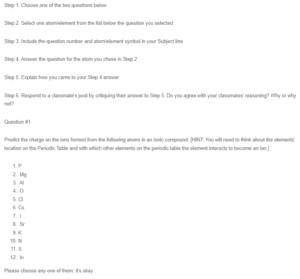Potassium Atom(K)
The atom selected is potassium (K). The charge formed on K in an ionic compound is +1. Potassium is a group 1 element. It belongs to the alkali metal group of the periodic table. Other metals in this group include sodium, lithium, cesium, rubidium, and francium. Alkali metals have one valence electron. This valence electron forms ionic linkages with oppositely charged ions to form ionic compounds. In addition, potassium has an atomic number of 19. Its outermost electron participates in ionic linkages with atoms with negative charges, such as chlorine, to form ionic compounds. The ease of losing an electron is high among group 1 elements and increases as one moves down the group. Ionic bonds are formed when the valence electron of the potassium atom is transferred permanently to another atom with electron deficiency, such as elements in the halogen class.
I selected potassium because it belongs to the alkali group of the periodic table and because of its ease of losing electrons to form ionic bonds. It also readily reacts with other atoms listed in the group, such as oxygen, chlorine, nitrogen, and sulfur, to form ionic bonds. Alkali metals react with other electron-deficient atoms to form ionic compounds. Cesium (Cs) is another atom in the list with similar properties to potassium and belongs to the same group as potassium. However, I did not choose Cs because of its highly violent reaction with commonly available atoms such as Cl. This may make its handling difficult under standard laboratory conditions. Other metals in the list that participate in ionic bonding include magnesium, aluminum, and indium. These metals, however, have lower reactivity than potassium and cesium. Magnesium is a group 2 element of alkaline earth metals, while indium and aluminum belong to group 3A elements.
ORDER A PLAGIARISM-FREE PAPER HERE
We’ll write everything from scratch
Question

Potassium Atom
Step 1. Choose one of the two questions below
Step 2. Select one atom/element from the list below the question you selected
Step 3. Include the question number and atom/element symbol in your Subject line
Step 4. Answer the question for the atom you chose in Step 2
Step 5. Explain how you came to your Step 4 answer
Step 6. Respond to a classmate’s post by critiquing their answer to Step 5. Do you agree with your classmates’ reasoning? Why or why not?
Question #1
Predict the charge on the ions formed from the following atoms in an ionic compound: [HINT: You will need to think about the elements’ location on the Periodic Table and with which other elements on the periodic table the element interacts to become an ion.]
- P
- Mg
- Al
- O
- Cl
- Cs
- I
- Sr
- K
- N
- S
- In
Please choose any one of them; it’s okay.


